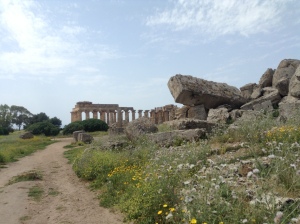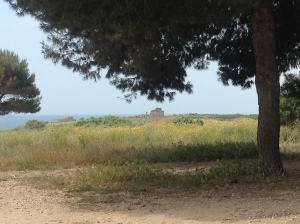On our recent trip to Sicily, we knew that a return visit to Selinunte had to be on the agenda.
Selinunte (Ancient Greek: Σελινοῦς; Latin: Selinus) was an ancient Greek city on the southern coast of Sicily in Italy. It was situated between the valleys of the Belice and Modione rivers. It now lies in the comune Castelvetrano, between the frazioni of Triscina di Selinunte in the west and Marinella di Selinunte in the east.
The archaeological site contains five temples centered on an acropolis.
Of the five temples, only the Temple of Hera has been re-erected.
Selinunte was one of the most important of the Greek colonies in Sicily, situated on the southwest coast of that island, at the mouth of the small river of the same name, and 6.5 km west of that of the Hypsas (the modern Belice River). It was founded, according to historian Thucydides, by a colony from the Sicilian city of Megara, or Megara Hyblaea, under the conduct of a leader named Pammilus, about 100 years after the settlement of that city, with the addition of a fresh body of colonists from the parent city of Megara in Greece.
The date of its foundation cannot be precisely fixed, as Thucydides indicates it only by reference to that of the Sicilian Megara, which is itself not accurately known, but it may be placed about 628 BCE. Diodorus places it 22 years earlier, or 650 BCE, and Hieronymus still further back, 654 BCE. The date from Thucydides, which is probably the most likely, is incompatible with this earlier epoch.
The name is supposed to have been derived from quantities of wild parsley that grew on the spot. For the same reason, they adopted the parsley leaf as the symbol on their coins.
Selinunte was the most westerly of the Greek colonies in Sicily, and for this reason was early brought into contact and collision with the Carthaginians and the native Sicilians in the west and northwest of the island. The former people, however, do not at first seem to have offered any obstacle to their progress; but as early as 580 BCE we find the Selinuntines engaged in hostilities with the people of Segesta (a non-Hellenic city), whose territory bordered on their own.
The river Mazarus, which at that time appears to have formed the boundary between the two states, was only about 25 km west of Selinunte; and it is certain that at a somewhat later period the territory of Selinunte extended to its banks, and that that city had a fort and emporium at its mouth. On the other side its territory certainly extended as far as the Halycus (modern Platani), at the mouth of which it founded the colony of Minoa, or Heracleia, as it was afterward termed. It is evident, therefore, that Selinunte had early attained to great power and prosperity; but there is very little information as to its history.
Like most of the Sicilian cities, it had passed from an oligarchy to a despotism, and about 510 BCE was subject to a despot named Peithagoras, from whom the citizens were freed by the assistance of the Spartan Euryleon, one of the companions of Dorieus: and thereupon Euryleon himself, for a short time, seized on the vacant sovereignty, but was speedily overthrown and put to death by the Selinuntines. The causes leading the Selinuntines to abandon the cause of the other Greeks, and take part with the Carthaginians during the great expedition of Hamilcar (480 BCE) are unknown; they had even promised to send a contingent to the Carthaginian army, which, however did not arrive till after its defeat.
The Selinuntines are next mentioned in 466 BCE, as co-operating with the other free cities of Sicily in assisting the Syracusans to expel Thrasybulus; and there is every reason to suppose that they fully shared in the prosperity of the half century that followed, a period of tranquility and opulence for most of the Greek cities in Sicily. Thucydides speaks of Selinunte just before the Athenian expedition as a powerful and wealthy city, possessing great resources for war both by land and sea, and having large stores of wealth accumulated in its temples.
We were well prepared for our hiking the ruins, as we were staying at the New Palace Hotel in Marsala
and were treated to the most marvelous breakfast each morning…
We so enjoyed this adventure in Sicily…….hope you did too!
Related articles
- Temples of Sicily – Selinunte and Segesta (garrulousgwendoline.wordpress.com)
- A drive around Sicily – Part 2 (embracelifebeinspired.com)
- An Ancient Greek SoHo? (history.com)






















What an interesting history – your pictures are beautiful!
Thank you……..it is quite difficult to take a “bad” photo of this place! It is so very magnificent.
What a wonderful journey the two of you have experienced. The photographs of the ruins are awe inspiring. We especially loved the photographs of the intrepid traveller. XX V.
Thank you my dearest. As you saw from our previous post of this place…..it is a most beautiful and wondrous place. Glad you enjoyed the pics of the travelers…….we rarely put out pics in the postings.
Love the pictures and thanks for sharing your journey. You presented it so well and it is so much more interesting on this blog compared to the world history course I was bored to death with in high school, years and years ago!!!!!!!!!!! Don’t remember that much about the course but I do remember the boredom!
So glad you enjoyed. It is one of the most beautiful place I have ever visited.
Have you ever taught history, Tin Man? I can see you bringing history to life in a classroom with slides of your travels. What a beautiful place! I almost needed my sunglasses to view the ruins drenched in sunlight. If I go hiking, I want to stay in a hotel like the New Palace Hotel. Thanks for sharing your tales and travels with us.
I have taught Art History (and lots of medically related classes) as adjunct faculty for San Antonio Community College District………..but now, in my old age, you give me thoughts of more. The New Palace Hotel is WONDERFUL …………… lol, yes, perfect for hiking preparation!!
I knew you must have lectured somewhere! Sometimes growing older gives us new choices and you have so many talents and skills.
Though I’m completely jealous of your recent travels I’m thoroughly enjoying the tales and the sight your sharing. The image at the temple looking up to the sky is such a great shot.
Thank you so much Jed. This was my second visit to this temple complex in the past year and out of all the shots I have taken, that one is my favorite! Glad you are enjoying the trip…..much more to come!
you went to Sicily? Jealous! love your photos too.
This was our second trip to Sicily this year. On this one we toured the entire island and all its nooks and crannies.
Why two trips in 6 months?
Why not………..you should ask! The first one was only to the Marsala area and we wanted to explore the entire island.
These wonderful pictures are what I expected Greece to look like, but found it didn’t. Obviously we should have gone to Sicily instead. And the hotel looks fabulous too!
Sicily has so many beautiful ruin and they are sparsely visited so they are very wonderful to explore. You MUST go some day and enjoy them. The hotel is perfection and I just love Marsala. Greece is not what the travel brochures make to be! This is another charm that Sicily offers……. a small island, just a 20 minute boat ride : https://the-tin-man.com/?s=mozia
I can see why you wanted to return to this site, it’s beautiful.
Beautiful and so sparsely visited. I so enjoy being there and imagining what it was like when it was at the pinnacle of its existence.